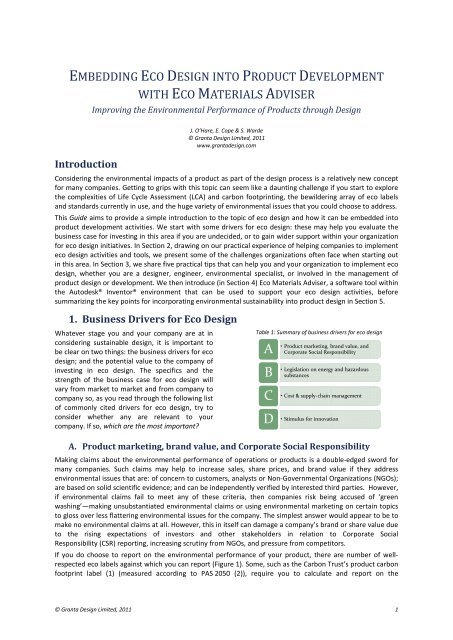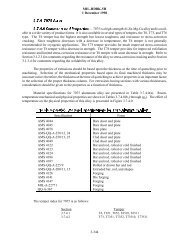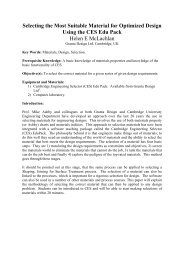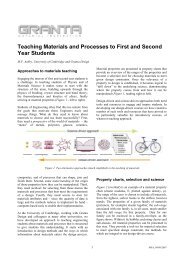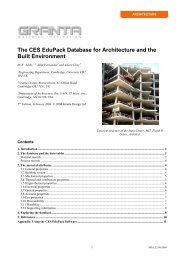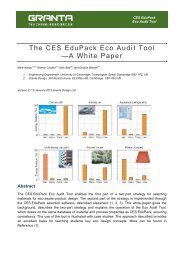A B C D - Introducing Eco Materials Adviser - Granta Design
A B C D - Introducing Eco Materials Adviser - Granta Design
A B C D - Introducing Eco Materials Adviser - Granta Design
You also want an ePaper? Increase the reach of your titles
YUMPU automatically turns print PDFs into web optimized ePapers that Google loves.
EMBEDDING ECO<br />
DESIGN INTO PRODUCT DEVELOPMENT<br />
WITH ECO MATERIALS ADVISER<br />
Improving the Environmental Performance of Products through <strong>Design</strong><br />
Introduction<br />
J. O’Hare, E. Cope & S. Warde<br />
© <strong>Granta</strong> <strong>Design</strong> Limited, 2011<br />
www.grantadesign.com<br />
Considering the environmental impacts of a product as part of the design process is a relatively new concept<br />
for many companies. Getting to grips with this topic can seem like a daunting challenge if you start to explore<br />
the complexities of Life Cycle Assessment (LCA) and carbon footprinting, the bewildering array of eco labels<br />
and standards currently in use, and the huge variety of environmental issues that you could choose to address.<br />
This Guide aims to provide a simple introduction to the topic of eco design and how it can be embedded into<br />
product development activities. We start with some drivers for eco design: these may help you evaluate the<br />
business case for investing in this area if you are undecided, or to gain wider support within your organization<br />
for eco design initiatives. In Section 2, drawing on our practical experience of helping companies to implement<br />
eco design activities and tools, we present some of the challenges organizations often face when starting out<br />
in this area. In Section 3, we share five practical tips that can help you and your organization to implement eco<br />
design, whether you are a designer, engineer, environmental specialist, or involved ved in the management of<br />
product design or development. We then introduce (in Section 4) <strong>Eco</strong> <strong>Materials</strong> <strong>Adviser</strong>, a software tool within<br />
the Autodesk® Inventor® environment that can be used to support your eco design activities, before<br />
summarizing the key points for incorporating environmental sustainability into product design in Section 5.<br />
1. Business Drivers for <strong>Eco</strong> <strong>Design</strong><br />
Whatever stage you and your company are at in<br />
considering sustainable design, it is important to<br />
be clear on two things: the business drivers for eco<br />
design; and the potential value to the company of<br />
investing in eco design. The specifics and the<br />
strength of the business case for eco design will<br />
vary from market to market and from company to<br />
company so, as you read through the following list<br />
of commonly cited drivers for eco design, try to<br />
consider whether any are relevant to your<br />
company. If so, which are the most important<br />
Table 1: Summary of business drivers for eco design<br />
A<br />
B<br />
C<br />
D<br />
• Product marketing, brand value, and<br />
Corporate Social Responsibility<br />
• Legislation on energy and hazardous<br />
substances<br />
• Cost & supply-chain management<br />
• Stimulus for innovation<br />
A. Product marketing, brand value, and Corporate Social Responsibility<br />
Making claims about the environmental performance of operations or products is a double-edged sword for<br />
many companies. Such claims may help to increase sales, share prices, and brand value if i they address<br />
environmental issues that are: of concern to customers, analysts or Non-Governmental<br />
Organizations (NGOs);<br />
are based on solid scientific evidence; and can be independently verified by interested third parties. However,<br />
if environmental claims fail to meet any of these criteria, then companies risk being accused of ‘green<br />
washing’—making unsubstantiated environmental claims or using environmental marketing on certain topics<br />
to gloss over less flattering environmental issues for the company. The simplest answer would appear to be to<br />
make no environmental claims at all. However, this in itself can damage a company’s brand or share value due<br />
to the rising expectations of investors and other stakeholders in relation to Corporate Social<br />
Responsibility (CSR) reporting, increasing scrutiny from NGOs, and pressure from competitors.<br />
If you do choose to report on the environmental performance of your product, there are number of well-<br />
respected eco labels against which you can report (Figure 1). Some, such as the Carbon Trust’s product carbon<br />
footprint label (1) (measured according to PAS 2050 (2)), require you to calculate and report on the<br />
© <strong>Granta</strong> <strong>Design</strong> Limited, 2011<br />
1
environmental impacts of your product, but do not set any minimum performance requirements. (However,<br />
applying the Carbon Trust label does at least commit you to reducing that footprint over the next two years).<br />
Other standards, such as EPEAT for IT equipment (3) or the EU Blue Angel mark (4), do set minimum<br />
performance targets that must be satisfied and verified before you can apply the label. For further guidance on<br />
making environmental claims see the recently revised guidance notes by the US Federal Trade Commission (5).<br />
Figure 1: Just some of the eco labels available.<br />
B. Legislation on energy and hazardous substances<br />
Environmental legislation is probably the most common driver for companies to initiate eco design activities.<br />
The Integrated Product Policy (6), adopted by the European Union in 2003, gave rise to a number of significant<br />
pieces of product-focused environmental legislation that affect many types of product sold within the EU.<br />
Table 2 gives other examples from the US, Asia, and Europe. As well as government laws and regulations,<br />
industry associations and NGOs are introducing standards, policies, and substance watch lists in an effort<br />
either to influence the regulatory framework, or to help companies track a complex, globalized picture. The<br />
challenge is not just one of geographical range—legislations, regulations, and standards now cover the entire<br />
product lifecycle, from substances in its manufacture to the way that it is managed at the end of its life.<br />
Table 2: Examples of issues now affected by legislation<br />
Lifecycle energy<br />
consumption of the<br />
product<br />
EU Energy-related Products (ErP) Directive<br />
Forthcoming Grenelle 2 regulations in France<br />
EU Registration Evaluation & Authorisation of Chemicals (REACH) Directive<br />
California Green Chemistry Initiative<br />
Use of hazardous<br />
substances<br />
EU Restriction of Hazardous Substances (RoHS) Directive<br />
‘China RoHS’<br />
Norwegian PoHS<br />
US Toxic Substances Control Act (TSCA)<br />
Use of batteries<br />
End-of-Life strategy for the<br />
product<br />
EU Batteries Directive<br />
EU Waste Electrical and Electronic Equipment (WEEE) Directive<br />
Japanese Household Appliance Recycling Law (HARL)<br />
EU End of Life Vehicles (ELV) Directive<br />
2 Embedding eco design into product development
C. Cost & supply-chain management<br />
Legislation may be forcing you to consider eco design, but there can also be clear cost benefits. By taking an<br />
eco design perspective during the design of a product, companies often find that they are able to reduce the<br />
manufacturing costs of a product because they reduce materials and energy usage, as well as eliminating<br />
waste.<br />
When the major environmental impacts of a product are related to a sub-system or component that is<br />
designed and manufactured by a supplier, eco design can provide a good opportunity to engage with these<br />
suppliers. This may result in a leaner, more cost-effective supply chain. This is certainly an ambition of<br />
companies such as Wal-Mart and Procter & Gamble who have begun extensive supply-chain reporting<br />
initiatives (7). These companies are asking suppliers to report on environmental issues such as energy usage,<br />
water usage, and CO 2 emissions. These data are then used to benchmark supplier performance and identify<br />
the environmental hotspots in their supply chain. Thus their eco design actions are reducing costs.<br />
D. Stimulus for innovation<br />
Companies can also discover opportunities for innovation when they consider the environmental impact of<br />
their products. For instance, Lightweight Medical (8) developed the award-winning LINT transport incubator:<br />
the use of carbon-fibres makes it >50% lighter than existing models, enabling easier movement and reductions<br />
in associated transport emissions. The Dyson ‘Airblade’ hand dryer uses high-efficiency electric pumps to force<br />
air through specially designed apertures that ‘cut’ water off the hands of the user as they slowly lift their hands<br />
out of the drying chamber. By blowing the water off the hands rather than trying to evaporate the water off as<br />
conventional hand-dryers do, Dyson claims that the Airblade requires ~77% less time and uses up to 80% less<br />
energy to dry hands (9). So designers and producers can deliver both functional benefits and environmental<br />
benefits. A simple analysis tool that can help you to identify this type of win-win innovation is the BEC<br />
Diagram (10).<br />
2. The Challenge of Implementing <strong>Eco</strong> <strong>Design</strong><br />
How companies have typically responded to eco design drivers<br />
If your company has decided that the business case for eco design<br />
is sufficiently strong to merit action, the first task is to establish<br />
what type of response is appropriate. To date, many companies<br />
have focused on reporting environmental performance and<br />
assessing the compliance of products against environmental<br />
regulations or standards. Initially, many of the environmental<br />
marketing claims made about products were based on limited<br />
evidence, or in some cases were misleading. This resulted in a<br />
backlash from environmental NGOs and consumer groups, who<br />
demanded greater transparency in these environmental claims.<br />
“To improve the environmental<br />
performance of products we<br />
must embed practical eco<br />
design tools and approaches<br />
early in the regular design<br />
process.”<br />
Guidance is now available on how to conduct a Life Cycle<br />
Assessment (LCA) and how to communicate the results: standards<br />
such as the ISO 1404X (11) and ISO 1402X (12) series have helped to improve significantly the quality and<br />
transparency of environmental marketing claims. Conventional LCA methods and technology, with their focus<br />
on very detailed analysis of environmental impacts of existing products, are by far the best-known class of<br />
tools for analyzing environmental impacts. The downside of these approaches is that they are aimed at use<br />
late-on or after the design process, and are too data- or effort-intensive to be adapted for use in an iterative<br />
manner early in design. They are thus of limited use in making practical improvements to environmental<br />
performance for the current generation of a product.<br />
Currently, the idea of addressing environmental impacts during design is in its infancy. It is seen as the<br />
preserve of dedicated eco specialists or consultants alone: they often find it hard to engage engineers and<br />
designers across the company in improving product sustainably. This Guide is based on the belief that to<br />
improve the environmental performance of products we must embed practical eco design tools and<br />
approaches early in the regular design process.<br />
© <strong>Granta</strong> <strong>Design</strong> Limited, 2011 3
• Environmental<br />
• When<br />
• As<br />
• To<br />
• <strong>Design</strong><br />
The challenges<br />
Before considering how to achieve this goal, it is worth asking why eco design is not already integral to the<br />
routine design process.<br />
Limited time<br />
impacts are just one of many constraints a designer must consider during product<br />
development. <strong>Design</strong>ers are constantly battling to balance often conflicting project requirements such<br />
as functional performance, cost, asthetics, regulatory compliance, and lead-time. <strong>Eco</strong> design adds yet<br />
another issue to consider and so, generally, only a very limited amount of time and effort can be spent<br />
on it.<br />
Poor integration with design activity<br />
eco design activities are treated as a separate stream, distinct from mainstream product<br />
development activities, they struggle to gain acceptance and quickly become marginalized. This is<br />
compounded by the fact that companies often employ environmental experts, either as consultants or<br />
as part of an Environment, Health & Safety (or similar) team, to consider environmental performance<br />
and undertake environmental assessments. If the environmental expert is not in regular contact with<br />
the design team the results of their analysis can often be ignored, either because the analysis is not<br />
presented in a way that is accessible and useful for designers, or because there is little follow-up to<br />
ensure that the analysis leads to design improvements.<br />
Increasingly complex and rapidly developing legislation<br />
we saw in Section 1B, product-focused legislation, regulations, and standards are becoming<br />
increasingly complex and demanding. Simply keeping track of their potential implications is a major<br />
information technology challenge that most companies have not begun to address.<br />
Take two examples:<br />
•The Energy-related Products Directive, which provides a framework for setting eco design<br />
targets for products such as high definition televisions, is a requirement for CE-marking in the<br />
EU. But the range of products affected is expanding and the ‘implementing measures’ set<br />
targets that become more stringent over time—development organizations need to make a<br />
start on embedding eco principles into their design of such products.<br />
•The European Restriction on Hazardous Substances (RoHS) legislation restricts the use of a<br />
number of hazardous materials in the manufacture of various types of electrical and electronic<br />
equipment. How do you know whether these substances are present in the materials you are<br />
choosing for your product<br />
<strong>Design</strong>ers’ requirements not considered<br />
improve the environmental performance of a product you first need to understand when and<br />
where the environmental impacts occur across the product lifecycle. The primary tool for building this<br />
understanding is Life Cycle Assessment (LCA). Unfortunately, many of the commercially available<br />
software packages that enable LCA studies have been developed with LCA practitioners in mind,<br />
requiring an expert knowledge of the LCA methodology to conduct the analysis and interpret the<br />
results. Most designers and engineers do not possess this knowledge, which creates a major barrier to<br />
implementing eco design. Furthermore, LCA software is unsuitable for use during the early stages of<br />
the design process because it often requires detailed information about how the product is<br />
manufactured and used, and the input of data that is unfamiliar or unavailable to designers.<br />
Lack of commitment / fear of cost<br />
teams are sometimes reluctant to begin eco design activities because of concerns about the<br />
true level of commitment behind their company’s rhetoric about wanting to improve a product's<br />
environmental performance. This may be because, until recently, companies have perceived eco<br />
design as a ‘nice to have’ capability. As they begin to investigate the manner in which eco design is<br />
typically implemented in today's manufacturing organizations, they are overwhelmed and quick to<br />
dismiss it as being an unnecessary and costly activity.<br />
4<br />
Embedding eco design into product development
3. Five tips to get you started<br />
In the remainder of this Guide, , we provide five simple tips that aim to help you to overcome these challenges<br />
and enable you to embed eco design activities into your existing design process in a cost-effective and<br />
manageable manner. These are drawn from our experiences (13) and from study of other publications offering<br />
advice on how to implement eco design activities (see, for example (14), (15), and (16)).<br />
The top tip for everyone<br />
eco design<br />
involved in<br />
Three tips for designers, engineers,<br />
and materials engineers<br />
Tip 1<br />
Consider<br />
environmental<br />
impact early in the<br />
design process<br />
Tip 2<br />
Imprecise data can<br />
guide good<br />
decisions<br />
It is widely claimed that 80% of a product’s<br />
overall environmental impact has been ‘built in’<br />
by the end of the conceptual design phase<br />
(Figure 2). At this point, the designer has typically<br />
selected materials and manufacturing processes,<br />
and defined the product lifecycle: these constrain<br />
not just the final economic cost but also fix many<br />
of the environmental costs.<br />
By evaluating environmental performance during<br />
this early stage, the relative environmental costs<br />
of different options can be considered, in much<br />
the same way as economic costs or material<br />
suitability would be evaluated. This enables<br />
changes to the design before significant project<br />
costs have been incurred, and avoids costly and<br />
time-consuming redesign.<br />
Committed<br />
Environmental<br />
Impact<br />
Engineers and designers, used to the precision<br />
with which physical properties are measured, can<br />
be disconcerted by the imprecision of eco-data<br />
where values are, at best, known to within 10%,<br />
and often with less certainty (20). However, it is<br />
important to realise that this does not prevent<br />
good decision-making, especially when the<br />
environmental impact of a particular life-phase<br />
dominates.<br />
For example, when selecting materials, the<br />
difference between those with really large and<br />
really small values of embodied energy or CO 2<br />
footprint can often be a factor of 1000 or more,<br />
so the imprecision still allows firm distinctions to<br />
be drawn (Figure 3). When the material-phase<br />
differences are small, other factors such as the<br />
recycle content of the material, its durability (and<br />
thus life-time), and the ability to recover and<br />
recycle scrap at end of life are more significant in<br />
making the selection.<br />
Figure 2: Illustration of design process against percentage of<br />
environmental impact committed<br />
Figure 3: : Firm conclusions can be drawn about the<br />
environmental impact of a material, even with imprecise data<br />
© <strong>Granta</strong> <strong>Design</strong> Limited, 2011<br />
5
Tip 3<br />
Consider the entire<br />
product system<br />
Tip 4<br />
<strong>Materials</strong> and<br />
process decisions<br />
are critical to<br />
environmental<br />
impact and eco<br />
design<br />
Environmental performance is often significantly<br />
affected by how the user interacts with a<br />
product, how it is maintained, the operating<br />
environment, and whether it is indeed the<br />
correct product for the user’s needs. Creativity<br />
methods such as the 9-Windows diagram (10)<br />
can help to promote thinking about the wider<br />
system in which a product will be used,<br />
optimizing the eco design for the product’s final<br />
use.<br />
One example of such thinking is to ensure that<br />
the design process considers the environmental<br />
impact of all phases of a product’s life—material,<br />
manufacture, transport, use, and disposal<br />
(Figure 4). This encourages designers to invest<br />
greatest effort in improving the environmental<br />
sustainability of the phases that carry the highest<br />
demand for energy or generate the most CO 2 .<br />
Doing this in the early stages of design will yield<br />
the maximum return on investment.<br />
Material and process decisions play a very<br />
important role in determining the environmental<br />
impacts of a product across the lifecycle because:<br />
• Extraction & processing of raw materials<br />
carries significant environmental impact<br />
• <strong>Materials</strong> choice determines feasible<br />
manufacturing processes and associated<br />
energy and material efficiency<br />
• Material mass can greatly influence<br />
energy consumption and CO 2 emissions<br />
in transport and use phases<br />
• The substances used in materials and<br />
their recyclability / reusability<br />
characteristics determine toxicity,<br />
restricted substance impacts, and the<br />
impact of a product at the end of its life<br />
Some key strategies for minimizing<br />
environmental impact of each life-stage are<br />
shown in Figure 4: many relate directly to<br />
materials characteristics. A critical point is that<br />
you cannot base “eco materials selection” simply<br />
on the “eco properties” of the constituent<br />
materials, such as embodied CO 2 , recycled<br />
content, or toxicity. You need to assess these<br />
properties in combination with mechanical,<br />
physical, thermal, and electrical properties.<br />
For example, when reducing CO2 emissions, it<br />
may be better to make a vehicle body out of a<br />
lightweight material such as a carbon fiber<br />
composite even if this raises the CO 2 emissions<br />
associated with the material production and<br />
manufacturing phases: the lower mass is likely to<br />
lead to a large reduction in use phase CO 2<br />
emissions and hence an overall improvement.<br />
Figure 4: : Environmental impact can be assessed for each life-stage of a product (Tip 3). <strong>Materials</strong> and process selection play an important<br />
role in determining environmental impacts and can be used in many eco design strategies (Tip 4.)<br />
6<br />
Embedding eco design into product development
The top tip for those involved in managing product design and development<br />
Tip 5<br />
Establish targets and the<br />
information systems to<br />
support them<br />
Companies that have successfully implemented eco design often have long-term, corporate-level targets for<br />
improving environmental performance. For instance, in 2010, Philips (19) set a range of corporate-level,<br />
environmental goals to be achieved by 2015. These include:<br />
• Improve energy efficiency of Philips products by 50% compared to 2009<br />
• Double global collection, recycling, and recycled materials in products in the same period<br />
Setting this type of target has two effects: it demonstrates the company’s long-term commitment to<br />
environmental performance and it establishes a framework within which targets can be set at the project<br />
level. Some companies have found it effective to ‘cascade’ these targets to the project level by including<br />
environmental impact reduction targets within product requirements specifications. This is because<br />
designers use product requirements to focus their design effort and assign design time.<br />
Defining targets helps to develop the right behavior in an organization. ion. But delivering on those targets<br />
requires the right tools.<br />
4. How <strong>Eco</strong> <strong>Materials</strong> <strong>Adviser</strong> supports your eco design activities<br />
<strong>Granta</strong> <strong>Design</strong> and Autodesk have collaborated to<br />
develop <strong>Eco</strong> <strong>Materials</strong> <strong>Adviser</strong>—a software tool<br />
available within Autodesk Inventor® that supports<br />
your eco design activities.<br />
<strong>Granta</strong>, a spin-out from Cambridge University and<br />
the pioneering work of Prof Mike Ashby, has core<br />
expertise in materials and process selection and<br />
materials information management, together with<br />
a strong understanding of the challenges of eco<br />
design (17).<br />
Autodesk is a world leader in digital prototyping<br />
software for manufacturing, building, construction,<br />
engineering, and entertainment.<br />
The Autodesk<br />
Inventor 3D CAD software products offer a<br />
comprehensive, flexible set of software for 3D<br />
mechanical design, product simulation, tooling<br />
creation, and design communication.<br />
Inventor is a natural place to embed eco design<br />
tools into the early stages of design—where<br />
changing the material and process choices costs<br />
least but matters most (Figure 5).<br />
Increasing cost<br />
<strong>Design</strong> Brief<br />
Conceptual <strong>Design</strong><br />
Embodiment <strong>Design</strong><br />
Detailed <strong>Design</strong><br />
Manufacture<br />
Use<br />
<strong>Eco</strong> <strong>Design</strong><br />
Tools<br />
Figure 5: <strong>Eco</strong> <strong>Design</strong> tools must focus on the early stages of<br />
product design, where choices matter most and cost least<br />
© <strong>Granta</strong> <strong>Design</strong> Limited, 2011<br />
7
A. Assessing environmental impacts<br />
<strong>Granta</strong> has developed <strong>Eco</strong> Audit technology that provides a quick and interactive means to determine the<br />
factors that make the greatest contribution to a product's environmental impact, and to make materials and<br />
process choices that minimize this impact.<br />
This rapid assessment helps engineers and designers to focus their efforts on the most significant life phases in<br />
the product lifecycle. They can experiment with 'what-if' scenarios during the early stages of design, before<br />
time has been spent and funds have been committed (see Tip 1).<br />
The <strong>Eco</strong> Audit calculations take some key information about the product as input—the materials and processes<br />
used, its transport, and use. This helps the user to consider the entire life cycle of the product (see Tip 3), as<br />
well as to clearly see the impacts of material and process decisions (Tip 4).<br />
The output is a report (Figure 6) showing graphs and tabular data of energy usage, CO 2 footprint, and other<br />
key indicators. The focus is on ease-of-use and speed. Accuracy is sufficient to drive key design decisions—<br />
e.g., substituting materials to reduce weight, or to cut embodied energy (see Tip 2).<br />
Figure 6: Part of an <strong>Eco</strong> Audit report showing energy usage throughout the product lifecycle for two variants on a product design<br />
B. <strong>Materials</strong> and environmental data<br />
Of course, such eco assessment requires the right data. <strong>Granta</strong>’s MaterialUniverse dataset provides generic<br />
property data on around 3,000 engineering materials and 240 processes—complete and normalized allowing<br />
comparison and selection for metals, ceramics, polymers, composites, and natural materials. Each material<br />
record provides engineering properties, eco properties (energies, emissions, end-of-life), plus cost data. All<br />
data is compiled, reviewed, and updated by <strong>Granta</strong> subject experts from some of the best sources available.<br />
C. Integration with CAD—<strong>Eco</strong> <strong>Materials</strong> <strong>Adviser</strong><br />
<strong>Eco</strong> <strong>Materials</strong> <strong>Adviser</strong> provides <strong>Granta</strong>’s <strong>Eco</strong> Audit technology as an easy-to-use, interactive tool within the<br />
Autodesk Inventor CAD system. The tool is accessed via the Environments tab within Inventor. It connects, via<br />
the Internet, to a Cloud-hosted database containing <strong>Granta</strong>’s MaterialUniverse data. The user can search and<br />
browse this database of materials and processes, apply materials to parts within their CAD model, and<br />
8 Embedding eco design into product development
instantly tly generate an eco impact dashboard (Figure 7). The effect of changes to the model or materials<br />
assignments can be explored interactively.<br />
The Base Version of <strong>Eco</strong> <strong>Materials</strong> <strong>Adviser</strong> is shipped as standard with Autodesk Inventor 2012. It uses a subset<br />
of around fifty materials from the <strong>Granta</strong> database and works on small assemblies (of up to twenty parts). It<br />
predicts energy usage, CO 2 footprint, water usage, and cost for the assembly, and indicates potential problems<br />
with RoHS legislation, food compatibility, or product end-of-life. These indicators are computed for the raw<br />
materials, manufacturing, and end-of-life phases of the product lifecycle.<br />
The Full Version augments these capabilities, using the MaterialUniverse data set of around 3,000 materials,<br />
with 18 key engineering ering properties and 29 eco properties available for each material. The calculations work on<br />
any Autodesk assembly and include the transport and use phases of the product lifecycle. The Full Version can<br />
be purchased from the product website at inventor.grantadesign.com.<br />
Figure 7: The <strong>Eco</strong> <strong>Materials</strong> <strong>Adviser</strong> tool delivers the <strong>Eco</strong> Audit technology within Autodesk Inventor software<br />
5. Summary<br />
This guide has provided an introduction to the topic of eco design. We began by discussing some of the<br />
commonly cited drivers for eco design: it is crucial to develop a sound business case by identifying which of<br />
these drivers are relevant for your company. Having acknowledged the challenges commonly encountered, we<br />
went on to offer five simple tips to help you achieve your eco design goals (Figure 8)<br />
For everyone<br />
For designers, engineers, materials engineers<br />
For managers<br />
Tip 1<br />
Tip 2<br />
Tip 3<br />
Tip 4<br />
Tip 5<br />
• Consider<br />
environmental<br />
performance<br />
early in the<br />
design process<br />
• Imprecise data<br />
can guide good<br />
decisions<br />
• Consider the<br />
entire product<br />
system<br />
• <strong>Materials</strong> and<br />
process<br />
decisions are<br />
critical to<br />
environmental<br />
impact and eco<br />
design<br />
• Establish targets<br />
and the<br />
information<br />
systems to<br />
support them<br />
Figure 8: <strong>Granta</strong>’s tips giving you the Five Tips to <strong>Eco</strong> <strong>Design</strong><br />
© <strong>Granta</strong> <strong>Design</strong> Limited, 2011<br />
9
<strong>Eco</strong> <strong>Materials</strong> <strong>Adviser</strong> helps you to implement these tips. It is:<br />
• Practical, simple, and quick to use<br />
• Integrated into the designer’s environment<br />
• Connected to trusted materials, process, and environmental information<br />
• Able to guide material and process selection<br />
• <strong>Design</strong>ed for rapid iteration and exploration of “what-if” scenarios<br />
• A complement to full LCA approaches<br />
Figure 9 summarizes how <strong>Eco</strong> <strong>Materials</strong> <strong>Adviser</strong> helps to meet the challenges identified in Section 2:<br />
Limited Time<br />
•Considering eco design early in your design process (Tip 1) will save you<br />
time and cost later—<strong>Eco</strong> <strong>Materials</strong> <strong>Adviser</strong> is integrated into CAD<br />
•Imprecise data can guide precise decisions (Tip 2)—early in design, <strong>Granta</strong>'s<br />
generic MaterialUniverse reference data can provide useful guidance<br />
without excessive effort<br />
Poor<br />
Integration<br />
•<strong>Materials</strong> and process decisions are central to environmental impact (Tip 4)<br />
so eco design must be considered right alongside cost & function as you<br />
make these decisions<br />
• <strong>Eco</strong> <strong>Materials</strong> <strong>Adviser</strong> integrates into your regular engineering workflow<br />
Legislation<br />
•You need the right tools to meet environmental targets (Tip 5)<br />
•<strong>Eco</strong> <strong>Materials</strong> <strong>Adviser</strong> provides direct information on RoHS compliance and<br />
allows designers to consider issues such as product end-of-life and energy<br />
usage that are the focus of many emerging eco regulations (Table 2)<br />
<strong>Design</strong>er's<br />
Needs<br />
•<strong>Eco</strong> <strong>Materials</strong> <strong>Adviser</strong> is designed for Autodesk Inventor users<br />
•The <strong>Eco</strong> Audit technology provides a simple method for estimating impact<br />
across the product lifecycle—a step towards considering the entire product<br />
system (Tip 3)<br />
•The focus is on guiding design decisions, not just measuring impacts<br />
Commitment<br />
•It helps to set corporate and project-level environmental targets (Tip 5)<br />
•Executives should ask “what tools and systems do we have in place to<br />
enable informed materials and process decisions”<br />
•<strong>Eco</strong> <strong>Materials</strong> <strong>Adviser</strong> is a tool that can help to meet this need<br />
Figure 9: How our tips and tools can meet the challenges of eco design identified in Section 2.<br />
With suitable processes and tools in place, you can not only begin to deliver on eco design, but can actually<br />
enhance innovation and reduce costs. If you would like further information, please contact us:<br />
info@grantadesign.com<br />
10<br />
Embedding eco design into product development
Sources<br />
1. The Carbon Trust. The Carbon Reduction Label. [Online] www.carbon-label.com.<br />
2. PAS 2050. BSI Standards. [Online] www.bsigroup.com/en/Standards-and-Publications/How-we-can-helpyou/Professional-Standards-Service/PAS-2050/.<br />
3. EPEAT. 'Green Electroncis Made Easy'. [Online] www.epeat.net.<br />
4. The Blue Angel. 'Active in climate protection'. [Online] www.blauer-engel.de/en/.<br />
5. US Federal Trade Commission. Guides for the use of environmental marketing claims. Part 260.<br />
6. COMMUNICATION FROM THE COMMISSION TO THE COUNCIL AND THE EUROPEAN PARLIAMENT.<br />
Integrated Product Policy - Building on Environmental Life-Cycle Thinking. 2003. Standard number:<br />
/*COM/2003/0302 final*/.<br />
7. Procter & Gamble. Supplier Environmental Sustainability Scorecard and Training <strong>Materials</strong>. PGSupplier.com.<br />
[Online] www.pgsupplier.com/supplier-environmental-sustainability-scorecard.<br />
8. Farish, N, et al. Developing sustainable healthcare products, p. 112-116. [book auth.] M Charter. Sustainable<br />
Innovation 05. Farnham : The Centre for Sustainable <strong>Design</strong>, 2005.<br />
9. The Dyson Airblade. 'Why Airblade Technology is better'. Dyson Ltd. [Online]<br />
www.dysonairblade.co.uk/technology/benefits.asp.<br />
10. O'Hare, J. <strong>Eco</strong>-innovation tools for the early stages: an industry-based investigation of tool customisation<br />
and introduction. University of Bath, PhD Thesis. [Online] April 2010.<br />
opus.bath.ac.uk/20208/1/UnivBath_PhD_2010_J_A_OHare.pdf.<br />
11. ISO 1404X series - International Organization for Standardization (ISO). Environmental mangagement<br />
standards - . e.g. ISO 14040:1997 and later documents. [Online]<br />
www.iso.org/iso/iso_catalogue/catalogue_tc/catalogue_detail.htmcsnumber=23151.<br />
12. ISO 1402X series - International Organization for Standardization (ISO). Environmental mangagement<br />
standards . e.g. ISO 14020:2000 and later documents. [Online]<br />
www.iso.org/iso/iso_catalogue/catalogue_tc/catalogue_detail.htmcsnumber=34425.<br />
13. Wegst, U.G.K. and Ashby, M.F. <strong>Eco</strong>-criteria for materials selection Engineering <strong>Design</strong>er. Engineering<br />
<strong>Design</strong>er. 24, 1998, Vol. 2, pp. 8-12.<br />
14. ISO 14062 - International Organization for Standardization (ISO). Environmental mangagement standards.<br />
ISO/TR 14062:2002. [Online]<br />
www.iso.org/iso/iso_catalogue/catalogue_tc/catalogue_detail.htmcsnumber=33020.<br />
15. IEC: International Electrotechnical Commission. IEC Guide 114. Environmentally conscious design<br />
Integrating environmental aspects into design and development of electrotechnical products. [Online] May<br />
2005. engineers.ihs.com/document/abstract/RQDZHBAAAAAAAAAA.<br />
16. McAloone, T and Bey, N. Environmental improvement through product development - a guide.<br />
Copenhagen : Techincal University of Denmark, 2009. ISBN 978-87-7052-950-1.<br />
17. Ashby, M.F. <strong>Materials</strong> and the Environment - <strong>Eco</strong>-Informed <strong>Materials</strong> Choice. 2009.<br />
18. Ashby, M.F. <strong>Materials</strong> Selection in Mechanical <strong>Design</strong> (4th edition). 2011.<br />
19. Philips. <strong>Eco</strong>Vision5. [Online] 2010. www.philips.com/about/sustainability/ourfocus/ecovision5.page.<br />
20. Hammond, G and Jones, C. Inventory of Carbon and Energy (ICE). [Online] 2006. www.bath.ac.uk/mecheng/sert/embodied/.<br />
About <strong>Granta</strong><br />
<strong>Granta</strong> <strong>Design</strong> is a spin-off from the University of Cambridge. Founded in 1994, <strong>Granta</strong> has grown to be the<br />
world leader in materials information technology, with customers in hundreds of top engineering enterprises<br />
and universities. <strong>Granta</strong> co-founder Professor Mike Ashby is a world authority on eco design, following many<br />
years of active research in the area, including the recent publication of the book MATERIALS AND THE<br />
ENVIRONMENT - ECO-INFORMED MATERIALS CHOICE (17).<br />
GRANTA MI and CES Selector are trademarks of <strong>Granta</strong> <strong>Design</strong> Ltd.<br />
Autodesk and Autodesk Inventor are registered trademarks of Autodesk, Inc.<br />
© <strong>Granta</strong> <strong>Design</strong> Limited, 2011 11


